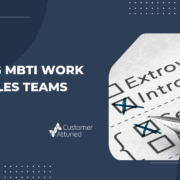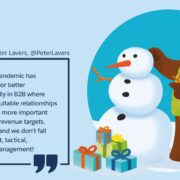This is the second in our series of posts focussed on the application of MBTI for sales teams. Our training and development programme considers the vital missing piece of the jigsaw in most MBTI based training for sales: understanding the natural preferred style of the customer and flexing our selling to better connect with them.
Moving to scale 3 – Thinking to Feeling
For each of the MBTI ‘scales’ we are considering three ‘BIG QUESTIONS’ which sales teams need to answer in order to flex their style with confidence as shown below –
- How do we spot the ‘scale’ position [ or style type ] with confidence
- What selling style/techniques will a customer with this preferred style type best respond to
- How should we communicate to better ‘connect’ with a customer of this type
We will now consider the above questions for the third MBTI ‘scale’ – Thinking to Feeling
Firstly a reminder of what we mean by Thinking versus Feeling in the MBTI context. This scale is all about the basis for our decision making – whether we make our decisions for emotionally driven reasons [ Feeling ] or rational/logical reasons [ Thinking ]. An example often used in MBTI training is that if finding a badly injured animal at the side of the road. Would you kill the animal in order to put it out of it’s pain/suffering [ a Thinking response ] or wrap your arms around it, comfort it and look to move it to a veterinary surgeon as quickly as possible [ a Feeling response ].
This scale has obvious application to sales – the key to good selling is to understand the core motivators of your customer contacts and to match your product/service benefits against motivators. Knowing that a contact is driven by emotional [ Feeling ] motivators rather than logical [ Thinking ] ones should radically change your whole pitch.
Let’s now consider our three BIG QUESTIONS in turn –
1. How do we spot this characteristic with confidence
THINKERS LOOK FOR:
- A fact based approach to decision making
- Will look for and examine evidence
- Requirement for more time to process all the available information before arriving at a decision
- Often want to sleep on a decision
- Do not openly talk about their feelings [ or those of others ]
- Generally of a stable/calm disposition
- Can be described as ‘all business’ or somewhat cold
- Harder to read body language – quite controlled and reserved
|
FEELERS LOOK FOR:
- Automatically consider the feelings/emotional responses of others when considering a business proposal.
- Less inclined to detail and process – more to impact on people
- Will show their feelings/mood quite openly
- Can make decisions quickly if the decision ‘feels’ right
- Can exhibit mood swings – good and bad days
- Will often want to refer decisions to others – take counsel before final decision.
- Open body language showing emotions – fill the space
|
Now let’s consider what selling style/techniques a customer with this style type best respond to ?
Utilise the guidelines below when selling –
THINKERS:
- Provide a fully quantified and fact based proposal – make the decision ‘feel’ logical
- Provide references and case studies
- Stick to business – minimise small talk
- Send detail in advance
- Present in a slower and step by step manner
- Expect slower decisions – allow them time to think
- Do not expect enthusiasm – a thoughtful/studious response
- Use silence – put your ideas forward in a fact based way then SHUT-UP and wait for their response.
- Listen very carefully – they are likely to be quietly spoken/thoughtful.
|
FEELERS:
- Ensure you include the impact on people in all pitches [ think about physical and emotional responses ]
- Pictures/visuals more than words/numbers
- Minimise detail and process [ have as an appendix or attachment ]
- Take time for small talk and get to know them personally before asking for major decisions
- Keep energy and enthusiasm high in pitches – physically demonstrate your belief in what you are selling
- Watch body language – their degree of buy-in will often be obvious.
- Ask lots of questions – involve them
|
Finally we focus on how we should communicate to better ‘connect’ with a customer of each preference –
THINKERS:
- With precision
- Slowly and calmly
- Supported by facts
- Lots of numbers, graphs, charts to build credibility
- Controlled but quietly confident body language
- Use carefully chosen language to build legitimacy
|
FEELERS:
- With enthusiasm
- Faster and shorter pitches
- Support with pictures/images
- Show your belief physically
- Energising words/phrases
- Talk to the individual not the business [ third person ]
|
As stated previously – it is a congruent combination of several of the above ‘flexes’ which will create a truly powerful selling argument – one which both sells effectively whilst building rapport and trust progressively.
In our MBTI for sales teams training, delegates practice both spotting types accurately and flexing their selling approach to connect powerfully with customers.
The above list is by no means exhaustive – look for other ‘clues’ in speech, body language and social preferences to help you.
2. Effective selling to extraverts vs introverts
Utilise the guidelines below when selling –
Extraverts:
- Keep presentations/pitches shorter
- Use pictures/visuals more than words
- Keep your personal energy high
- Express obvious belief in what you are selling
- Vary your tone – regular high energy injections are critical to maintain engagement
- Get them involved in developing the solution
- Forget pre-meeting work
- Close early – sale can be very fast
|
Introverts:
- Provide the detail
- Provide evidence – words supported by pictures
- Remain calm and paced
- Focus on quiet credibility
- Consistent authoritative tone/delivery
- Provide ‘expert opinion’
- Send pre-work/reading in advance
- Provide time for reflection – they may genuinely ‘want to sleep on it’
|
3. Communicate better to connect more effectively
Extraverts:
- High energy
- Faster pace
- Repeat carefully chosen motivational words
- [ often focussed on major customer benefits ]
- Focus on simple ‘storyline’
- Focus on outcomes
|
Introverts:
- Calm Clear
- Regular/slower pace
- The devil is in the detail
- Fact/evidence based
- Credible references and quotes matter
- Outline processes impacted
|
A word of caution – look for congruence in customer communications – sales people need to find several clues to type before deciding on their flexing.
In our MBTI training we simulate both the spotting of types in ‘real-world’ situations and the flexing of delivery to better connect with customers.
In the next article we will consider the Myers Briggs Sensing to Intuition scale and how knowledge of your customers type can allow flexing of selling style.
Have a view on this? or
Contact us at hello@customerattuned.com
Read more about MBTI for Sales Teams:

Mark is a co-founder and Director of Customer Attuned Ltd. He holds a Doctorate from the University ofSouthampton, his thesis focused on Trust as a dynamic within business to business customer relationships.
He is an expert in B2B Customer Experience and Customer Management. This includes CM strategy development; execution of improvement plans (incl. organisational modelling for customer management); programme design; and partnership & alliance development.
Mark's applied work across FMCG, industrials, medical devices, financial services, business services and construction has led to organisations making, significant improvements to their customer management. A large focus of this work has been moving organisations up the Trust Ladder to enable them to benefit from reduced cost to serve, while continuing to innovate and deliver mutual value.
Mark is a Fellow of the Chartered Institute of Marketing and Member of the Institute of Sales and Marketing Management. He holds an MBA in strategy from Henley Business School.
Latest posts by Dr Mark Hollyoake
(see all) 

